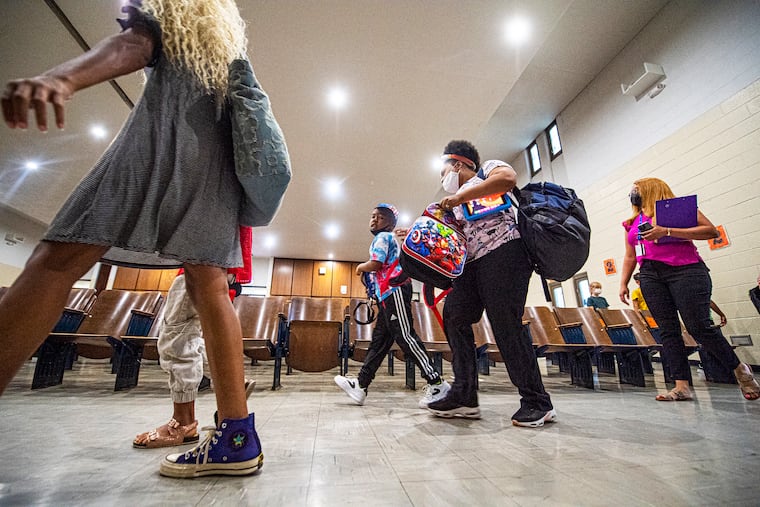Proposed $5B boost for Pa. schools would result in 18,000 new K-12 jobs and more grads going to college, new research says
University of Pennsylvania analysts have quantified the long-term benefits of a $5.1 billion proposal to change the state's education funding.

The lawmakers who made a $5.1 billion proposal to change the way Pennsylvania funds education said they believed it would result in significant long-term benefits for the state and the seven million children who attend public schools across the commonwealth.
An analysis released by the University of Pennsylvania Graduate School of Education on Tuesday quantified exactly what the projected benefits could be:
Improved student outcomes including an additional 3,800 high school graduates, a 4.47% point increase in high school graduation rates, a 4.54% point increase in college enrollment and 3,860 more college enrollees, according to the report. Societal benefits include higher earnings for high school graduates over time; and greater equity in staffing across districts — with teacher salaries in underfunded districts like Philadelphia’s possibly increasing by more than $7,000. Another benefit, researchers said, would be the creation of more than 18,000 K-12 jobs.
» READ MORE: Pa. House took a step to change the school funding system — and now must convince the Senate to sign on
Though the proposal to put Pennsylvania on a path to discharging its duty to provide a thorough and efficient public education carries a steep price-tag, the benefits of improving school quality outweigh the cost, said Brooks Bowden, associate professor of education and head of the Center for Benefit-Cost Studies of Education. Bowden led the research.
“Our analysis shows it would represent a strategic investment that would pay off for the state and its students,” Bowden said in a statement. “Students would have better access to teacher and counselors, succeed in higher numbers, and strengthen the state’s workforce.”
The backdrop
After a landmark 2023 Commonwealth Court decision found that Pennsylvania’s existing education funding system fails to meet students’ constitutional rights by failing to provide sufficient resources for schools, a judge ordered lawmakers to come up with a fix. Districts now lean on local property taxes to fund school systems, resulting in a system that leaves low-wealth districts unable to raise enough money to adequately fund their public schools.
The Basic Education Funding Commission spent months holding hearings and designing a system that would pour the $5.1 billion in additional funding into state schools over seven years.
For the 2024-25 school year, the proposal would increase education spending by $864 million statewide, with Philadelphia getting an additional $242 million.
Though the state House gave its stamp of approval to the new system, the Senate must still sign off, and some Republicans have signaled they have concerns.
Student achievement impact
Bowden, along with researchers David Loeb and Katie Pullom, examined existing research to predict “notable impacts” on high school graduation rates, postsecondary enrollment and more.
In addition to rising graduation rates, there’s an impact on “the actual human capital,” Bowden said — “students’ learning, their experiences over time — mean that the students in the system who would have graduated anyway end up with higher salaries because they’re more skilled. It benefits students in ways more than we’re able to quantify.”
For students entering ninth grade next year, the proposal would cost $660 million, but yield $1.3 billion, the Penn analysis found. Younger students stand to see even more benefits — for incoming sixth grade, the cost is $1.8 billion but benefit is $2.8 billion, and for students entering kindergarten in 2024-25, the cost is $4.3 billion, but the benefits are worth $5.2 billion.
The staggered approach to ramping up funding “allows the students who are in high school today to benefit, but it also means that students who are younger will see more years of increased quality,” Bowden said.
Researchers said they took a “conservative approach” to their work, assuming the benefits will apply to about one-third of Pennsylvania students. Their analysis accounts for inflation and projected enrollment.
Particular benefits for districts like Philadelphia
The education funding proposal will have significant effect on staffing discrepancies between well-funded districts and poor systems like Philadelphia’s.
In all, 82% of underfunded systems would see student-teacher and student-counselor ratios rise to match those of well-funded ones, the researchers found. In addition to generating more than a projected 18,000 jobs in Pennsylvania schools, the investment could result in teacher salaries rising by more than $7,000 in those systems. (The average teacher salary in well-funded districts is now $78,621, and $65,216 in underfunded districts.)